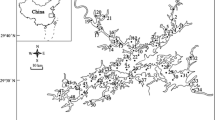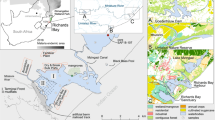Abstract
Screening of potential pollutants in surface sediments revealed that almost all persistent organochlorine pesticides were not detected in the newly flooded Mesopotamian wetlands of southern Iraq. This observation suggests that there has been minimal input of organochlorine pesticides recently except for p,p′-DDE which was the only pesticide residue detected (0.29–2.33 μg/kg). It was found in all samples indicating its ability to persist under severe drying of previously exposed surface sediments, high temperature, and intensive solar radiation. p,p′-DDE appears to have a negative relationship with wetland biota, such as zooplankton.
Similar content being viewed by others
References
Barber LB, Keefe SH, Brown GK, Taylor HE, Antweiler RC, Peart DB, Plowman TI, Roth DA, Wass RD (2003) Organic and trace element contaminants in water, biota, sediment, and semipermeable membrane devices at the Tres Rios treatment wetlands, Phoenix, Arizona. Water-Resources Investigations Report 03–4129, United States Geological Survey, Denver, p 89
Bengtsson BE (1978) Use of a harpacticoid copepod in toxicity tests. Mar Pollut Bull 9:238–241. doi:10.1016/0025-326X(78)90378-8
DouAbul AZ, AI-Omar M, AI-Obaidy S, AI-Ogaily N (1987a) Organochlorine pesticide residues in fish from the Shatt Al-Arab river, Iraq. Bull Environ Contam Toxicol 38:674–680. doi:10.1007/BF01608602
DouAbul AZ, Al-Saad HT, Al-Rekabi HN (1987b) Residues of organochlorine pesticides in environmental samples from the Shatt al-Arab river, Iraq. Environ Pollut 43:175–187. doi:10.1016/0269-7491(87)90154-0
DouAbul AZ, Al-Saad H, Al-Timari A, Al-Rekabi H (1988) Tigris-Euphrates delta: a major source of pesticides to the Shatt Al-Arab river (Iraq). Arch Environ Contam Toxicol 17:405–418. doi:10.1007/BF01055178
DouAbul AZ, Mahamed SS, Warner BG, Abaychi JK, Alwash AJ (2005) Restoration processes in Abu Zarag–Central marsh: a case study. Paper presented at the 9th annual meeting of the Ecological Society of America, special session 9: restoration of Mesopotamian Marshes of Iraq. August 9, 2005, Montreal
DouAbul AZ, Mahamed SS, Warner BG, Abaychi JK (2006) Are the Mesopotamian wetlands in Iraq a sink or source for pollutants in the Arabian Gulf? Paper presented at the American Society of Limnology and Oceanography 2006 Summer Meeting—June 4–9, 2006, Victoria
Habib OS (2005) Environment and health in southern Iraq: facts and future prospects. Mar Mesopot 20:7–19
Hwang H-M, Green PG, Young TM (2006) Tidal salt marsh sediment in California, USA. Part 1: occurrence and sources of organic contaminants. Chemosphere 64:1383–1392. doi:10.1016/j.chemosphere.2005.12.024
Jablonski PE, Ferry JG (1992) Reductive dechlorination of trichloroethylene by the CO-reduced CO-dehydrogenase enzyme complex from Mehanosarcina thermophila. FEMS Microbiol Lett 96:55–60. doi:10.1111/j.1574-6968.1992.tb05393.x
Kale SP, Murthy NBK, Raghu K, Sherkhane PD, Carvalho FP (1999) Studies on degradation of 14C-DDT in the marine environment. Chemosphere 39:959–968. doi:10.1016/S0045-6535(99)00027-2
Pfaender FK, Alexander M (1972) Extensive microbial degradation of DDT in vitro and DDT metabolism by natural communities. J Agricult Food Chem 20:842–846. doi:10.1021/jf60182a045
Pinkney AE, McGowan PC (2006) Use of the p,p′-DDD: p,p′-DDE concentration ratio to trace contaminant migration from a hazardouswaste site. Environ Monit Assess 120:559–574. doi:10.1007/s10661-005-9103-7
Quensen JFIII, Mueller SA, Jain MK, Tiedje JM (1998) Reductive dechlorination of DDE to DDMU in marine sediment microcosms. Science 280:277–280. doi:10.1126/science.280.5364.722
Richardson CJ, Hussain NA (2006) Restoring the garden of Eden: an ecological assessment of the marshes of Iraq. Bioscience 56:477–489. doi:10.1641/0006-3568(2006)56[477:RTGOEA]2.0.CO;2
Richardson CJ, Reiss P, Hussain NA, Alwash AJ, Pool DJ (2005) The restoration potential of the Mesopotamian marshes of Iraq. Science 307:1307–1311. doi:10.1126/science.1105750
Rushdi AI, DouAbul AAZ, Mohammed SS, Simoneit BRT (2006) Compositions and sources of extractable organic matter in Mesopotamian marshland surface sediments of Iraq: II. Polar compounds. Environ Geol 50:1171–1181. doi:10.1007/s00254-006-0289-y
Saeed T, Al-Ghandban N, Al-Shemmari H, Al-Mutair M, Al-Hashash H (1999) Preliminary assessment of the impact of draining of Iraqi marshes on Kuwait’s northern marine environment, Part II: sediment associated pollutants. Wat Sci Tech 40:89–98. doi:10.1016/S0273-1223(99)00587-9
Salim MA, DouAbul A, Porter RF, Rubec CD (2005) Birds: a key element of a biodiversity survey in the marshes of Iraq. Paper presented at the 9th annual meeting of the Ecological Society of America, special session9: restoration of Mesopotamian Marshes of Iraq. August 9, 2005, Montreal
US EPA (Environmental Protection Agency) (2006) Health effects support document for 1,1-dichloro-2,2bis (p-chlorophenyl) ethylene (DDE). EPA document number EPA-822-R-06-0007, p 117
US EPA (United States Environmental Protection Agency) (2003) Announcement of regulatory determinations for priority contaminants on the drinking water contaminant candidate list; notice. Fed Reg 68:42897–42906
USAID (United States Agency for International Development) (2006) Iraq marshlands restoration program. Final Report, p 528
WHO (World Health Organization) (2003) DDT and its derivatives. In guidelines for drinking-water quality, 3rd edn. World Health Organization, Geneva
You G, Sayles GD, Kupfele MJ, Kirn IS, Bishop PL (1996) Anaerobic DDT biotransformation: enhancement by application of surfactants and low oxidation reduction potential. Chemosphere 32:2269–2284. doi:10.1016/0045-6535(96)00121-X
Zeng EY, Venkatesan MI (1999) Dispersion of sediment DDTs in the coastal ocean off southern California. Sci Total Environ 229:195–208. doi:10.1016/S0048-9697(99)00064-9
Acknowledgments
We are grateful to the Canada-Iraq Marshlands Initiative, University of Waterloo and the Canadian International Development Agency (CIDA) for support. TDI-Brooks International, Texas graciously performed all laboratory analyses. We thank the local wetland dwellers for field assistance, without whose involvement, this study would not have been possible.
Author information
Authors and Affiliations
Corresponding author
Rights and permissions
About this article
Cite this article
DouAbul, A.A.Z., Mohammed, S.S., Warner, B.G. et al. Persistent DDE in the Mesopotamian Wetlands of Southern Iraq. Bull Environ Contam Toxicol 82, 690–693 (2009). https://doi.org/10.1007/s00128-009-9677-9
Received:
Accepted:
Published:
Issue Date:
DOI: https://doi.org/10.1007/s00128-009-9677-9




